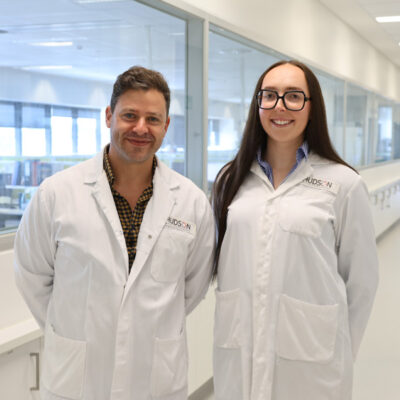Change in sleep position could help preterm babies
By Hudson Institute communications. Reviewed by Associate Professor Flora Wong

A simple change of sleeping position, from face down to face up, could greatly decrease the risk of brain injury and disability for extremely preterm babies, born between 24 and 29 weeks.

While advances in medical care have increased survival rates for early preterm babies, the first weeks of life are the most tenuous for these tiny patients. One of the biggest challenges is ensuring they get enough oxygen to reduce the risk of brain injury and life-long disability.
Currently, most preterm babies in intensive care are placed in the prone position (face down) to sleep as it is believed this improves breathing and increases oxygen to the brain.
A study by Associate Professor Flora Wong, who is Research Group Head at Hudson Institute and Monash University, and a neonatologist at Monash Health, and PhD student Kelsee Shepherd, has found that, in the first crucial weeks of life, placing extremely preterm babies in the prone position reduces oxygen to the brain.
“We have shown that there is no evidence that this position improves their long-term outcomes, in fact it may be detrimental,” said A/Prof Wong.
“The first week is one of the highest risk, so a simple change of sleeping position could provide a basic change to practice across the world, which would increase oxygen, reduce brain injury and life-long disability to preterm infants.”
Learning from SIDS
- The research published in the Journal of Pediatrics was undertaken because the sleeping position for preterm infants in intensive care is the opposite to term babies who are placed in a supine position (face up) – a position that is encouraged to prevent Sudden Infant Death Syndrome.
- Fifty-six preterm infants (28 girls and 28 boys) took part in the study during the first weeks of their life. Researchers analysed the infants’ oxygen levels to their brain.
Premature birth facts
Australia
- Nine per cent of births, more than 27,000 babies, are born prematurely each year.
- Premature birth is the number one cause of newborn deaths.
- One in five preterm babies require resuscitation at birth.
- Over 48,000 babies are admitted into neonatal intensive and special care units every year in Australia.
- This is over 14.5 per cent of all babies born and translates to over 115 admissions each day.
Worldwide
- Fifteen million babies are born preterm. That is more than 1 in 10 babies.
- Preterm birth complications are the leading cause of death among children under five years of age, about 1 million deaths in 2015.
- Many survivors face a lifetime of disability.
- Three quarters of these deaths could be prevented with current, cost-effective treatments.
Next steps
The study was undertaken in stable preterm babies. To verify the findings, A/Prof Wong and her team will extend the study to unstable, at-risk babies.
A/Prof Wong aims to take the research to clinical trial, where face down sleeping will cease for extremely preterm babies in their first week of life. The outcomes from the trial may inform clinicians when deciding on techniques to protect the preterm brain.
Collaborators | Baker Heart and Diabetes Institute, Monash Newborn, Monash University
This research was supported by | NHMRC, the Scottish Cot Death Trust, Victorian Government
Journal | Journal of Pediatrics
Title | Effects of Prone Sleeping on Cerebral Oxygenation in Preterm Infants
View publication | https://doi.org/10.1016/j.jpeds.2018.08.076
In this article
About Hudson Institute
Hudson Institute’ s research programs deliver in three areas of medical need – inflammation, cancer, women’s and newborn health. More
Hudson News
Get the inside view on discoveries and patient stories
“Thank you Hudson Institute researchers. Your work brings such hope to all women with ovarian cancer knowing that potentially women in the future won't have to go through what we have!”





